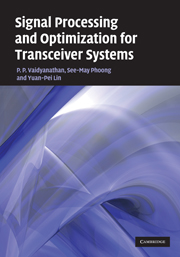Book contents
- Frontmatter
- Contents
- Preface
- Acknowledgements
- Part 1 Communication fundamentals
- 1 Introduction
- 2 Review of basic ideas from digital communication
- 3 Digital communication systems and filter banks
- 4 Discrete-time representations
- 5 Classical transceiver techniques
- 6 Channel capacity
- 7 Channel equalization with transmitter redundancy
- 8 The lazy precoder with a zero-forcing equalizer
- Part 2 Transceiver optimization
- Part 3 Mathematical background
- Part 4 Appendices
- Glossary
- Acronyms
- References
- Index
4 - Discrete-time representations
from Part 1 - Communication fundamentals
Published online by Cambridge University Press: 05 August 2011
- Frontmatter
- Contents
- Preface
- Acknowledgements
- Part 1 Communication fundamentals
- 1 Introduction
- 2 Review of basic ideas from digital communication
- 3 Digital communication systems and filter banks
- 4 Discrete-time representations
- 5 Classical transceiver techniques
- 6 Channel capacity
- 7 Channel equalization with transmitter redundancy
- 8 The lazy precoder with a zero-forcing equalizer
- Part 2 Transceiver optimization
- Part 3 Mathematical background
- Part 4 Appendices
- Glossary
- Acronyms
- References
- Index
Summary
Introduction
The digital communication system described in Chap. 2 is reproduced in Fig. 4.1. This system contains both continuous-time and discrete-time quantities. The signal xc(t) entering the channel is a continuous-time interpolated version of the sequence s(n), whereas the signal ŝ(n)at the receiver is a sampled version of the filtered received signal. It is often convenient to represent the communication system entirely in terms of equivalent discrete-time quantities such as digital filters. This is indeed possible based on the relationship between continuous-time signals and their uniformly sampled versions. In this chapter we first describe this interconnection (Secs. 4.2 and 4.3). This is done both for SISO channels and MIMO channels. The raised cosine function, which arises in the context of pulse shaping, is described in Sec. 4.4. The multiuser communication system is briefly described in Sec. 4.5. In Secs. 4.6–4.8 we discuss equalization of the digitized channel using digital filters, under the so-called zero-forcing constraint. Section 4.9 contains further remarks on the digital design of pre and postfilters. Digital equalizers without zero forcing (so-called minimum mean square error equalizers) will be introduced in Sec. 4.10.
Notations. Whenever it is necessary to distinguish continuous-time quantities from discrete-time we use the subscript c (continuous) or d (discrete). Where no subscript is used, the distinction will be quite clear from the context. The notation δc(t) denotes the continuous-time Dirac delta function, and δ(n) denotes the discrete-time impulse.
Information
- Type
- Chapter
- Information
- Signal Processing and Optimization for Transceiver Systems , pp. 113 - 166Publisher: Cambridge University PressPrint publication year: 2010
